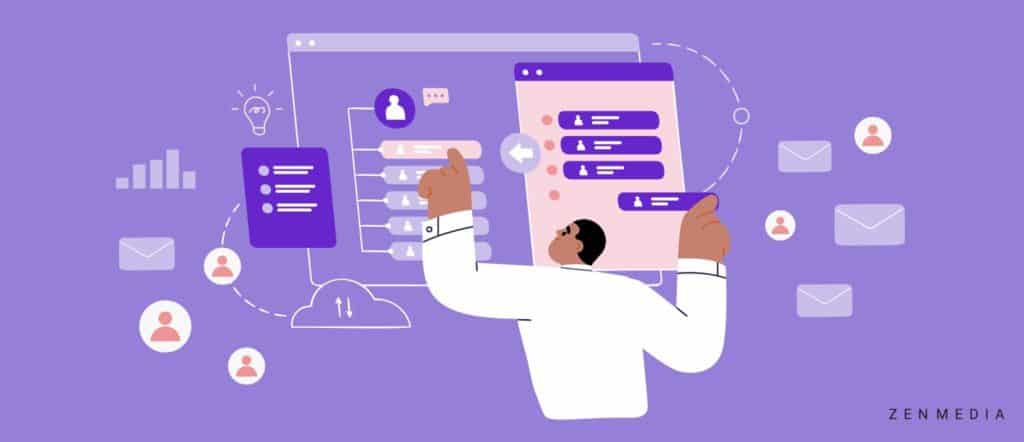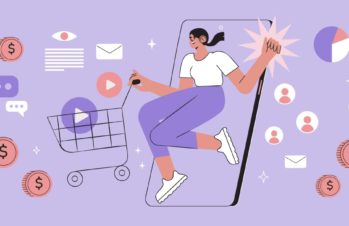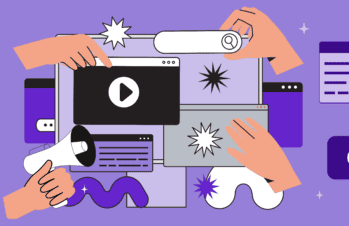In light of Web 3.0 and the developments of our cookieless future, some marketers and paid ads professionals are panicking—but they needn’t be. While the use of cookies is becoming increasingly limited, making it more difficult for businesses to collect data about their customers through third-party sources—first-party data is here to save the day.
But what is first-party data? How can it be used in place of third-party data? Can we really get enough insights to run successful ad campaigns without those sweet, sweet (and moderately unethical) cookies? Read on.
What is first-party data?
First-party data refers to information collected directly from a company’s sources. Rather than “spying” via cookies, this data comes directly from the source—your customer’s behaviors and direct feedback. Some examples of first-party data include:
- Website analytics: Data collected from a business’s website, such as page views, click-through rates, and bounce rates.
- CRM data: Information collected from a company’s customer relationship management (CRM) system, such as customer demographics, purchase history, and contact information.
- Email marketing data: Data collected from a business’s email marketing campaigns, such as open rates, click-through rates, and conversion rates.
First-party data can be used to better understand a company’s customers, including their preferences, behaviors, and pain points. This information helps marketers create highly targeted ads more likely to resonate with specific audiences. Additionally, first-party data can be used to personalize the customer experience, improve customer service, and increase overall customer loyalty.
Related reading: The Death of Third-Party Cookies: What It Means for B2B Brands
First-Party vs. Third-Party Data
When it comes to paid ads campaigns, first-party and third-party data each have their unique value. While both types of data can be used to create targeted ads, there are some key differences between the two that businesses should be aware of.
As we mentioned, first-party data is collected directly from a business’s sources and is considered highly accurate and valuable because it helps marketers gain a deeper understanding of their customers. In contrast, third-party data is collected from external sources, such as social media, surveys, and public records. While third-party data can also be valuable, it is not as accurate as first-party data and may not provide as detailed a picture of a business’s customers. Additionally, third-party data can be expensive to acquire and may not be as up-to-date as first-party data.
In other words, first-party data is like the inside scoop—a consensual wiretap, if you will—on your customers, while third-party data is like gossip from the neighborhood. One is secure and private while the other can be a little unreliable.
The development of Web 3.0 is marked by decentralization, with the use of blockchain, peer-to-peer networks, and other technologies that allow for more secure and private data transfer. The use of cookies, which are small data files that track user activity on a website (i.e. collecting third-party data), is becoming increasingly restricted due to privacy concerns. Many browsers, such as Safari and Firefox, have already implemented third-party cookie blocking, and Google Chrome plans to phase out third-party cookies by 2024.
These developments make it more difficult for businesses to collect data about their customers through third-party sources, making first-party data even more important. By collecting data directly from their own sources, such as website analytics and CRM systems, businesses can gain a deeper understanding of their customers—of course, this means that businesses need to get people to their websites and to interact with their content to gain first-party data—which is where paid ads come in.
Ad Personalization with First-Party Data
As we’ve noted, one of the biggest benefits of using first-party data in paid ads campaigns is the ability to personalize ads. Personalized advertising is when ads are tailored to specific individuals or groups based on their preferences, behaviors, and other characteristics. By using first-party data, businesses can create highly targeted ads that are more likely to resonate with their target audience.
For example, a business that sells tactical outdoor gear can use first-party data from its website analytics to identify B2B customers who have shown an interest in military-grade camping equipment. This information can be used to create personalized ads that feature camping gear and target those customers specifically.
A tech business offering a learning management system could do something similar. Using CRM data to identify customers who have purchased an older version of an LMS or another training product, marketers can target them with ads for the updated versions or similar organizational products.
By personalizing ads in this way, businesses can improve the effectiveness of their B2B paid ads campaigns and see better results in terms of click-through rates, conversion rates, and overall ROI.
Related reading: Paid Media: Your Guide to Making it Work in 2023
First-Party Data Strategy
To fully leverage the power of first-party data in paid ads campaigns, businesses need to develop a comprehensive first-party data strategy. This strategy should include steps for collecting and organizing first-party data, as well as best practices for using this data in paid ads campaigns.
- Collection and organization: To collect first-party data, businesses can use tools such as website analytics, CRM systems, and email marketing platforms. Once collected, this data should be organized (and protected) in a way that makes it easy to analyze and use in ad personalization.
- Best practices: When using first-party data in paid ads campaigns, it’s important to ensure that the data is accurate, up-to-date, and compliant with data privacy laws. Additionally, businesses should be transparent with customers about how their data is being used and give them the option to opt out of targeted advertising.
- Tools and platforms: Various tools and platforms can help businesses with first-party data analysis and ad personalization. These include marketing automation platforms, data management platforms (DMPs), and customer data platforms (CDPs).
By developing a comprehensive first-party data strategy, businesses can ensure that they are making the most of this valuable asset and using it to drive better results in their B2B paid ads campaigns.
Additionally, as a part of the strategy, it’s important to regularly review, update and refresh the data, especially when it comes to customer data, as their preferences, behaviors, and needs can change over time.
First-Party Data Marketing
First-party data is not only valuable for paid ads campaigns; it can be leveraged and used to help direct your overall B2B marketing strategy.
By incorporating first-party data insights into other marketing channels, brands can personalize email marketing campaigns, create targeted content, and improve customer service. For example, by using CRM data, a business can segment its email list and send targeted emails to specific groups of customers based on their purchase history.
With a deeper understanding of customer preferences and behaviors, businesses can make data-driven decisions about product development, pricing, and messaging. Overall, incorporating first-party data into a company’s marketing strategy can lead to more effective digital campaigns and a better understanding of customers, which can lead to improved customer loyalty, retention, and sales.
By understanding the value of first-party data and how it can be used across various channels, businesses can create a holistic approach to connect and engage with their customers and increase their lifetime value.
Final thoughts (TLDR)
Third-party data is out. First-party data is in—and we all need to adapt ASAP.
First-party data is a valuable resource that can be used to personalize ads and optimize ad spend by allocating the most dollars to the most effective segments, leading to better ROI. To fully leverage the power of first-party data, businesses need to develop a comprehensive first-party data strategy. This strategy should include steps for collecting and organizing first-party data, as well as best practices for using this data in paid ads campaigns.
Incorporating first-party data gained from ad campaigns, B2B email marketing, and website analytics into a company’s overall marketing strategy can lead to more effective campaigns and a better understanding of customers, leading to improved customer loyalty, retention, and sales.
Related reading: Cookieless B2B Marketing in 2023
It’s important to note that using first-party data in a compliant, transparent, and ethical way is crucial to maintaining customer trust and avoiding potential legal issues. By understanding the value of first-party data, businesses can create a holistic approach to connect and engage with their customers and increase their lifetime value.
Need help collecting first-party data and understanding how to use it in your paid ad strategy? We can help.




